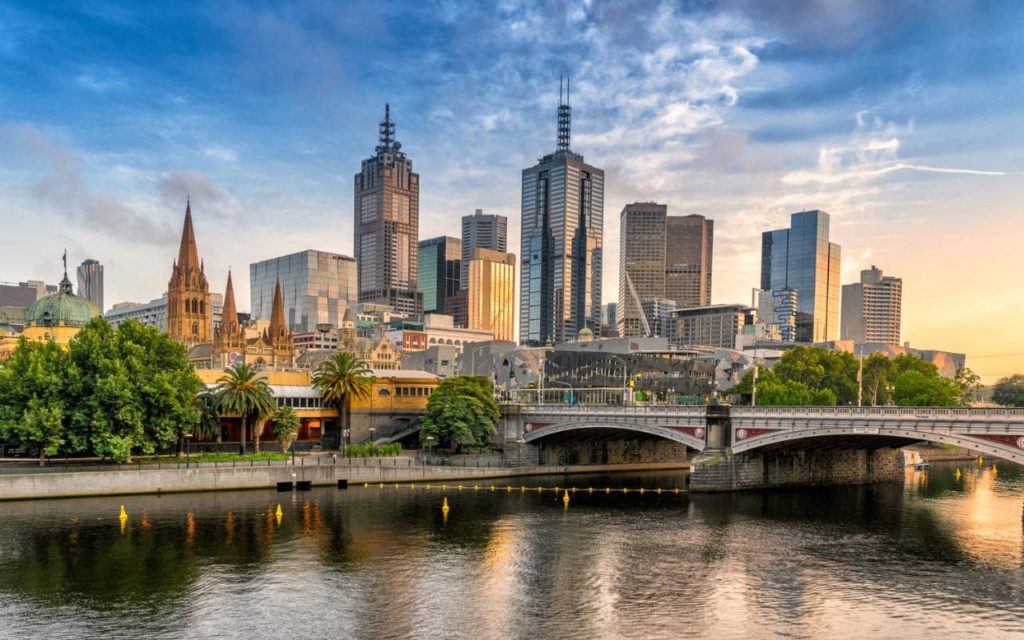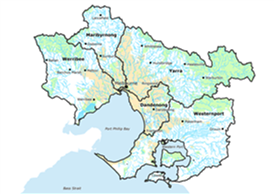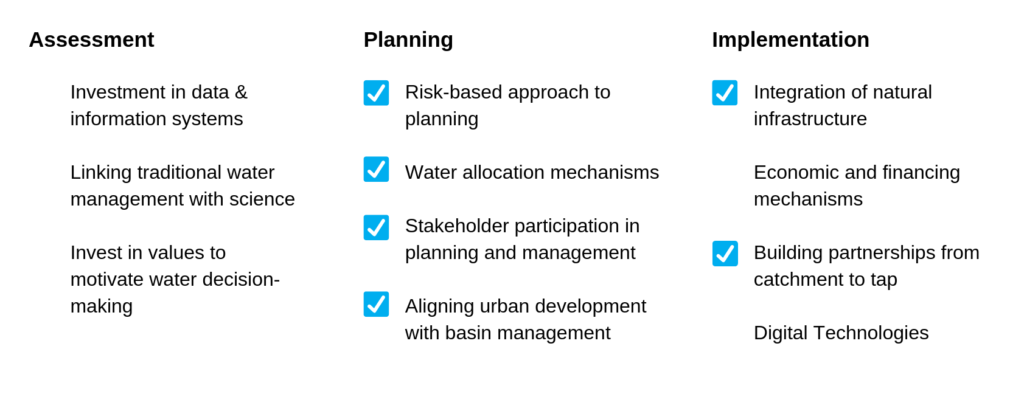An integrated planning approach to keep Melbourne a liveable, water sensitive city
Melbourne is the state capital of Victoria and Australia’s second biggest city. Facing a variable climate; the region is facing more periods of extreme heat and drought, reductions in annual rainfall and increases in intense rainfall events. Together with sea level rise and an increased risk of floods and bushfires, these environmental hazards have led to new challenges, including changing vegetation, growth of invasive species, and increasing health impacts associated with urban heat.
As a leader in world class integrated water, sewerage, and waterways management, Melbourne Water led a series of strategic conversations with stakeholders and the community across the region to identify the best ways to respond to these complex challenges and associated opportunities to keep Melbourne a liveable, water sensitive city. These include strategies on: a) Flood Management, b) the Water System, c) Drinking Water Quality and d) Healthy Waterways. Melbourne Water believes an integrated planning approach is needed to make the most of the water supply systems, whilst using water efficiently and optimising the use of diverse sources of water such as stormwater and recycled water for different purposes.
The Melbourne Basin
The Melbourne Basin, which spans the Port Philip and Westernport region contains more than 24,000 kilometers of rivers and creeks, 33 estuaries and 14,000 natural wetlands; three of which are listed as internationally significant under the Ramsar Convention. As a highly populated and vibrant city, the current population is expected to almost double by 2065 – increasing the demand for water and bringing significant water resource management challenges for the city and the surrounding region. With growth and a changing and variable climate, a concerted effort is required for the region to uphold its liveability, while meeting the basic social, environmental and economic needs of its people.
1. The Problem

Bushfire damage from the Waroona fire, January 2016, Australia. Photo by Gnangarra/commons.wikimedia.org
Melbourne faces several climate risks including less rainfall and more chance of drought; extreme heatwaves and bushfires; intense rainfall and wind storms; and the impact of sea level rise. Over the years, Melbourne has been challenged with extreme climatic events which have impacted their water resources. In 2006, water storages received the lowest annual inflows on record, with storages dropping from 58.4% in January to 39.0% in December. In 2009, the region experienced devastating bushfires which damaged about 30% of Melbourne’s water supply catchments, reducing water storages levels of the Thomson Dam to 25.6%; the lowest level recorded since the Dam began filling in 1984.
Melbourne has also experienced substantial flood events. In the Port Phillip and Western Port region, approximately 232,000 properties are estimated to be at risk of flooding (with at least a 1% chance per year). The annual average damage caused by flooding is estimated to be AUD $399 million. In addition, the ongoing population growth and urbanisation is expected to generate more storm water (due to increasing built infrastructure) and sewage. This presents challenges to infrastructure and natural environments, but also opportunities to capture new resources such as reclamation and reuse of stormwater and wastewater.
2. The solution – Working with stakeholders
In a rapidly changing world, it is no longer possible to develop a single infrastructure plan based on what has happened in the past. Melbourne water has the role of managing and protecting Melbourne’s major water resources on behalf of the community, consequently is well placed to lead a series of strategic conversations with stakeholders and the community across the region to identify the best ways to respond to these complex challenges and associated opportunities in order to keep Melbourne a liveable, water sensitive city. Some strategies developed to tackle these challenges include:
- The Melbourne Water System Strategy, which presents a system view of water resource management across Melbourne and the surrounding region over the next 50 years. This strategy articulates an innovative approach to facilitate transformational change of the sewerage system in the face of complex challenges and opportunities.
- The Drinking Water Quality Strategy, which considers how to manage water quality from the catchments where the rain falls, right to the tap of consumers.
- The Healthy Waterways Strategy, which expresses the broad regional vision for Melbourne Water’s waterways.
- The Flood Management Strategy, which sets out a vision for flood management across the region and creates a framework to help guide the work of the organisations who participate in preventing or managing flood risks. This Strategy sets out how to work, understand, avoid and reduce flood risks and how Melbourne Water can support flood emergency preparation and response.
Proper implementation of these strategies require an integrated planning approach in order to make the most of the water supply system, whilst using water efficiently and optimising the use of diverse sources of water such as stormwater and recycled water for different purposes.
‘Doing it together’
Whether it is maintaining waterway health, creating spaces for the community to enjoy, or building and maintaining the world-class water, sewerage and flood management infrastructure, Melbourne Water aims to do this in concert with the community and stakeholders.
The Melbourne Water System Strategy and Flood Management Strategy were prepared in close collaboration with stakeholders, and are now being implemented collaboratively. These strategies will be supported by a 50-year Sewerage Strategy which will ensure Melbourne Water can adapt and respond to the increasing demands that urban growth and climate change are placing on the wastewater system. Similar to other Melbourne Water activities, the community is at the centre of the Healthy Waterways Strategy. The collaboration was based on early engagement, empowerment, and building relationships through a series of workshops, collaboration labs, opportunities to provide formal comments, working groups, site visits, community listening posts, individual meetings and an engagement web site.
3. Lessons Learned
Melbourne Water has worked together with the community to create adaptable pathways to ensure they are well placed to make timely decisions about resource use and infrastructure needs to keep Melbourne a liveable, water sensitive city. So far Melbourne Water has met with 450 people from over 250 organisations across the basin to shape the Healthy Waterways Strategy and reflect on their role in waterway health. A systematic approach to integrated management planning is being embedded through the development of place-based “Integrated Water Management Forums” which brings stakeholders together to discuss challenges and collective solutions. Five forums have been set up in metropolitan Melbourne. Moving forward the aim is to develop more integrated and decentralised Integrated Water Management plans to meet a range of outcomes – thus achieving a wider range of liveability and resilience benefits – consistent with the IWA Principles for Water-wise Cities.
What are the Drivers for Action?
For more information on the Drivers for Action visit the Action Agenda for Basin-Connected Cities
Pathways for Action
For more information on the Pathways for Action visit the Action Agenda for Basin-Connected Cities
4. Useful links
List of useful links providing additional information:
Melbourne Water corporate and strategic plans/strategies: https://www.melbournewater.com.au/about-us/publications-and-policies/strategic-and-corporate-plans
About the contributor
Melbourne Water is a government owned statutory authority that supply affordable, high-quality water, reliable sewerage, healthy waterways, integrated drainage and flood management services and outstanding natural community spaces that help make Melbourne a fantastic place to live. Find out more here: https://www.melbournewater.com.au/






